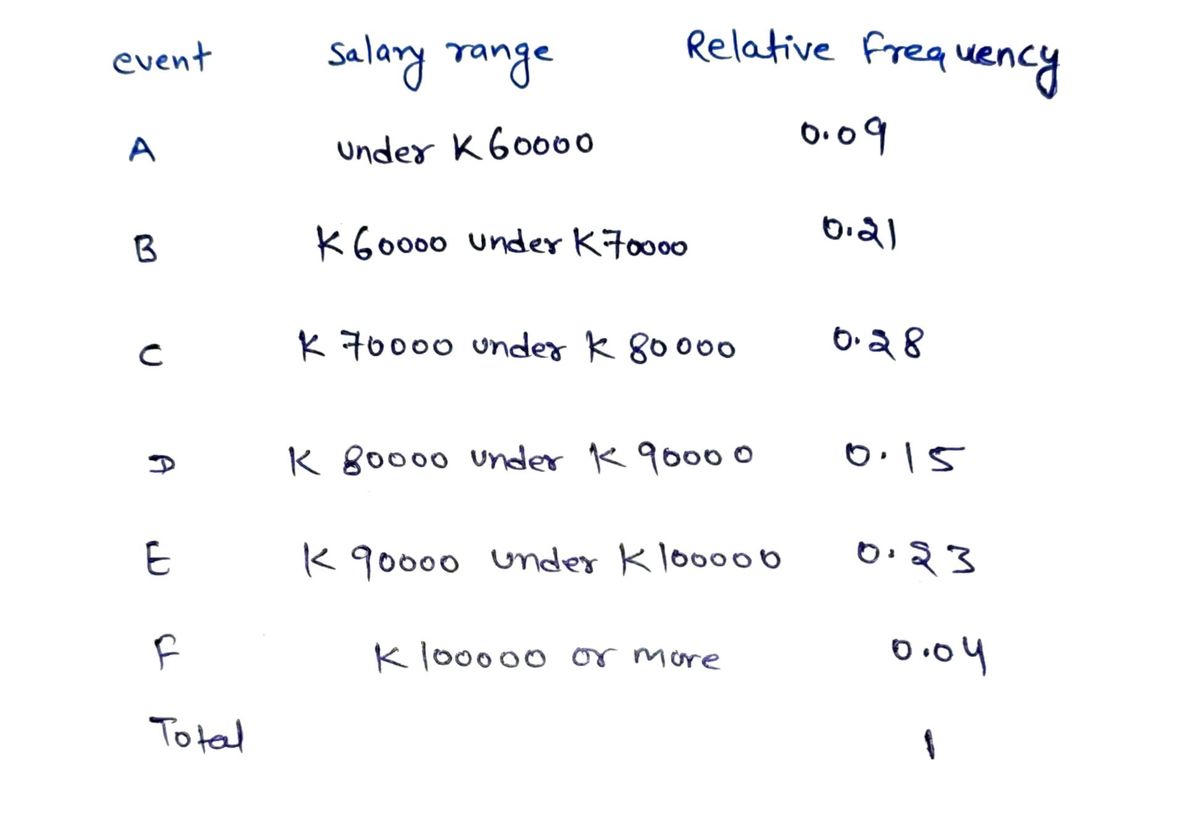The following table shows the relative frequency of executive salaries a particular organization. Event Salary range Relative Frequency A Under K60000 0.09 B K60000 under K70,000 0.21 C K70,00 under K80,000 0.28 D K80,000 under K90,000 0.15 E K90,000 under K100,000 0.23 F K100,000 or more 0.04 Total 1 (i) Determine the probability that a randomly selected executive has a salary greater than or equal to k70,000 but less than k100,000. (ii) Determine the probability that a randomly selected executive has a salary that is either less than k60,000 or greater than or equal to k90,000. (iii) Are the events A through F mutually exclusive?
The following table shows the relative frequency of executive salaries a particular organization. Event Salary range Relative Frequency A Under K60000 0.09 B K60000 under K70,000 0.21 C K70,00 under K80,000 0.28 D K80,000 under K90,000 0.15 E K90,000 under K100,000 0.23 F K100,000 or more 0.04 Total 1 (i) Determine the probability that a randomly selected executive has a salary greater than or equal to k70,000 but less than k100,000. (ii) Determine the probability that a randomly selected executive has a salary that is either less than k60,000 or greater than or equal to k90,000. (iii) Are the events A through F mutually exclusive?
MATLAB: An Introduction with Applications
6th Edition
ISBN:9781119256830
Author:Amos Gilat
Publisher:Amos Gilat
Chapter1: Starting With Matlab
Section: Chapter Questions
Problem 1P
Related questions
Question
The following table shows the relative frequency of executive salaries a
particular organization.
| Salary |
Relative Frequency | |
| A | Under K60000 | 0.09 |
| B | K60000 under K70,000 | 0.21 |
| C | K70,00 under K80,000 | 0.28 |
| D | K80,000 under K90,000 | 0.15 |
| E | K90,000 under K100,000 | 0.23 |
| F | K100,000 or more | 0.04 |
| Total | 1 |
(i) Determine the probability that a randomly selected executive has a salary
greater than or equal to k70,000 but less than k100,000.
(ii) Determine the probability that a randomly selected executive has a salary
that is either less than k60,000 or greater than or equal to k90,000.
(iii) Are the events A through F mutually exclusive?
Expert Solution
Step 1

Step by step
Solved in 2 steps with 2 images

Recommended textbooks for you

MATLAB: An Introduction with Applications
Statistics
ISBN:
9781119256830
Author:
Amos Gilat
Publisher:
John Wiley & Sons Inc

Probability and Statistics for Engineering and th…
Statistics
ISBN:
9781305251809
Author:
Jay L. Devore
Publisher:
Cengage Learning

Statistics for The Behavioral Sciences (MindTap C…
Statistics
ISBN:
9781305504912
Author:
Frederick J Gravetter, Larry B. Wallnau
Publisher:
Cengage Learning

MATLAB: An Introduction with Applications
Statistics
ISBN:
9781119256830
Author:
Amos Gilat
Publisher:
John Wiley & Sons Inc

Probability and Statistics for Engineering and th…
Statistics
ISBN:
9781305251809
Author:
Jay L. Devore
Publisher:
Cengage Learning

Statistics for The Behavioral Sciences (MindTap C…
Statistics
ISBN:
9781305504912
Author:
Frederick J Gravetter, Larry B. Wallnau
Publisher:
Cengage Learning

Elementary Statistics: Picturing the World (7th E…
Statistics
ISBN:
9780134683416
Author:
Ron Larson, Betsy Farber
Publisher:
PEARSON

The Basic Practice of Statistics
Statistics
ISBN:
9781319042578
Author:
David S. Moore, William I. Notz, Michael A. Fligner
Publisher:
W. H. Freeman

Introduction to the Practice of Statistics
Statistics
ISBN:
9781319013387
Author:
David S. Moore, George P. McCabe, Bruce A. Craig
Publisher:
W. H. Freeman